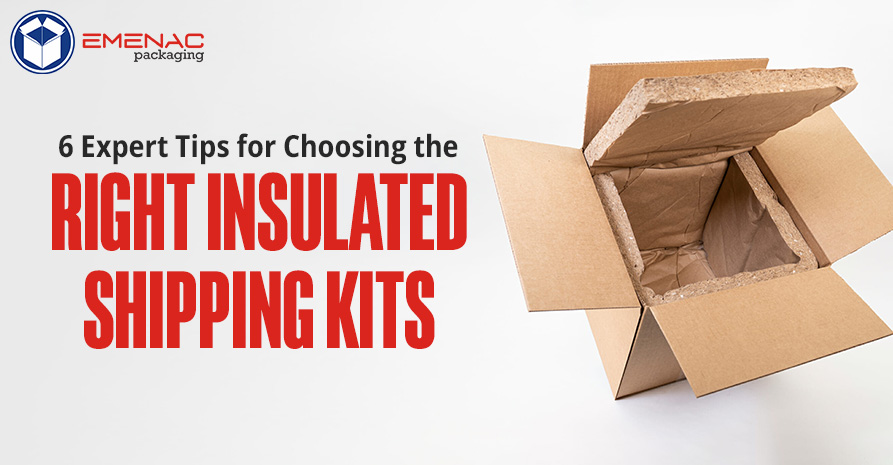6 Expert Tips for Choosing the Right Insulated Shipping Kits

Long gone are the days when medication and gourmet food were either not considered deliverable or arrived in poor condition. Insulated shipping box kits are literally a stroke of genius, enabling the transportation of temperature-sensitive items safely.
As per the Journal of Food Distribution Research, insulated kits can reduce spoilage by up to 60% for fresh products.
But the story doesn’t end here.
According to another report, grocery retailers suffer losses of up to £7 billion annually due to the low quality of insulated shipping kits.
Now, the question is, how will you identify the right choice for your brand? No worries! We are here to educate our customers about choosing the right kit.
6 Expert Tips: Choose The Right Insulated Shipping Kits
Do you want to save your business from negative reviews and impressions over the insulated kits, even after spending a fortune?
Then read till the end, as we have come up with tips that can help you make an accurate choice.
1. Various Temperature Requirements
There is a temperature variation depending on the product. Even the same brand can have different varieties of items and their freezing points.
Where the seafood temperature requirement is -20°C, vaccines range from 2–8°C strictly. So you need to discover the balance, and that can be done by defining the data:
- Acceptable temperature range
- Transit duration
- Worst-case external situations and seasonal temperatures
- Product volume and density
After you get the data, your options are already narrowed down to the relevant ones you are looking for: a basic foam cooler or a highly engineered solution.
2. Evaluate Insulation Materials
Now comes the insulation material, because not all are alike, and without checking that, you can’t select the right insulated shipping kits.
Here are some of the popular choices and their features:
- EPS
Expanded polystyrene is budget-friendly, lightweight, but provides moderate insulation properties.
- Polyurethans
Offers high thermal performance with thinner walls, but at a higher price.
- VIP: Vacuum-insulated panels
Offer the best thermal resistance with minimal thickness, but are expensive and delicate.
- Reflective metallised films
Useful as liners for short-duration or last-mile deliveries, but less effective alone for long transit times.
From local to international shipping, you can select according to the distance and the time, aligning these factors with the products.
3. Choose the Right Coolant and Quantity
Insulated shipping kits usually require coolants to sustain the target temperatures. Common coolants include:
- Gel packs
- Dry ice
- Phase change materials (PCMs)
Consider these factors when calculating coolant needs:
- Ambient temperatures during transit
- Shipping duration: same-day vs. multi-day
- Package size and insulation performance
Either use the instructions given by the manufacturer or do a thermal test before shipping.
4. Factor in Regulatory and Safety Compliance
There are some regulatory factors implemented by regional governing bodies that you have to follow. From pharmaceuticals to dry ice shipments and food shipments, you must ensure that your insulation kit complies with all safety measures.
Make sure to choose a supplier with prior experience in shipping on your routes. They will know how to fulfil the regulations as they have proven experience in shipping.
5. Optimise Package Design for Cost Efficiency
This point always confuses businesses, as factors like insulation quality and the size of the shipment can impact the cost. Depending on the dimensional weight, carriers will charge you per shipment.
Use the following points to optimise that cost:
- Choose an insulation material that provides necessary protection yet minimal bulk.
- Don’t waste the space in the packaging box; use custom inserts.
- For frequent shipments, use reusable systems.
It’s easier when you get a consultation from packaging experts to guide you.
With an efficient design, you can not only reduce freight charges but also decrease the warehouse space requirement.
6. Don’t Forget Durability and Branding Opportunities
Temperature is surely the top priority for insulated shipping kits, but you can take this as a branding opportunity. With custom printing, branded tape, or even a thoughtful unboxing experience, you get a chance to enhance the shopping experience for customers.
For this, you need to choose kits that allow:
- Exterior branding on corrugated shippers
- Inserts with instructions, branding, or coupons
- Eco-friendly materials
Partner with Experienced Packaging Suppliers
Choosing the best insulated shipping kits is like ensuring the safety of your products and profit! Especially for an e-commerce brand, your clients are putting their trust in you when ordering temperature-controlled products.
The accurate solution for the brand is to work with manufacturers who provide solutions after listening to your requirements. And our experts are ready to book a consultation with you and find a personalised solution for your brand’s cold-chain logistics.
 Apparel Boxes
Apparel Boxes
 Bakery Boxes
Bakery Boxes
 Cosmetics Boxes
Cosmetics Boxes
 Medicine Boxes
Medicine Boxes
 Retail Boxes
Retail Boxes